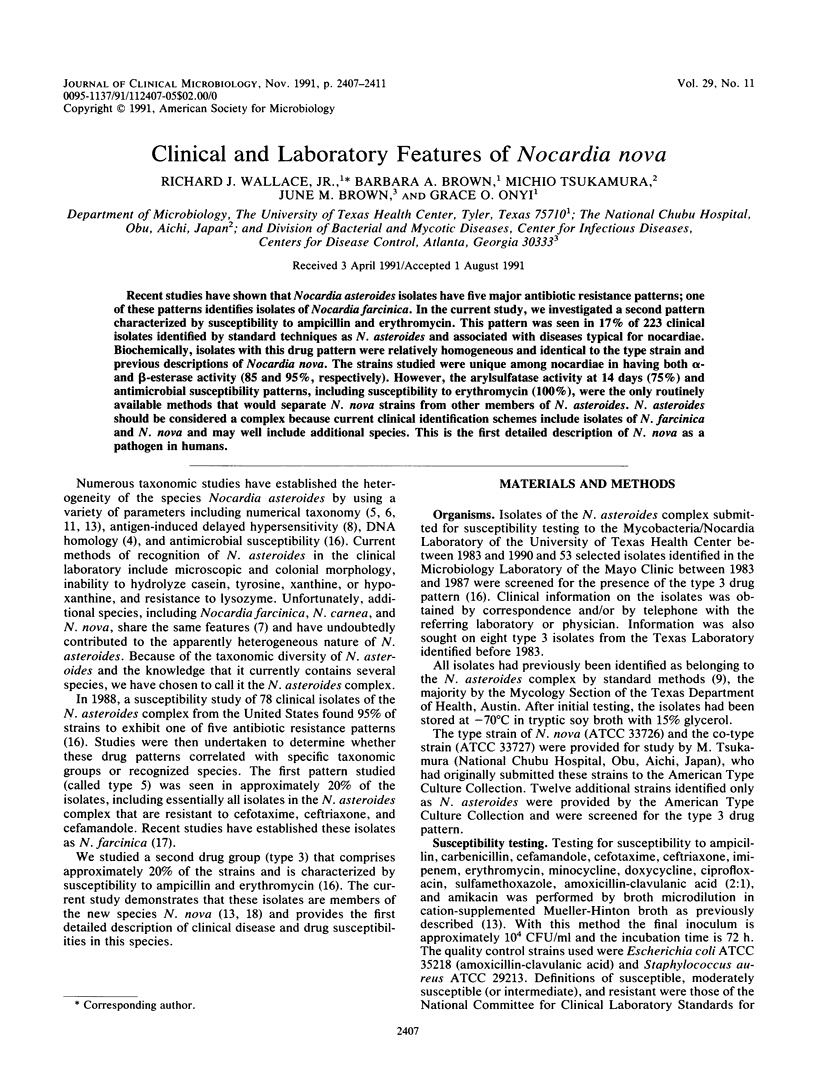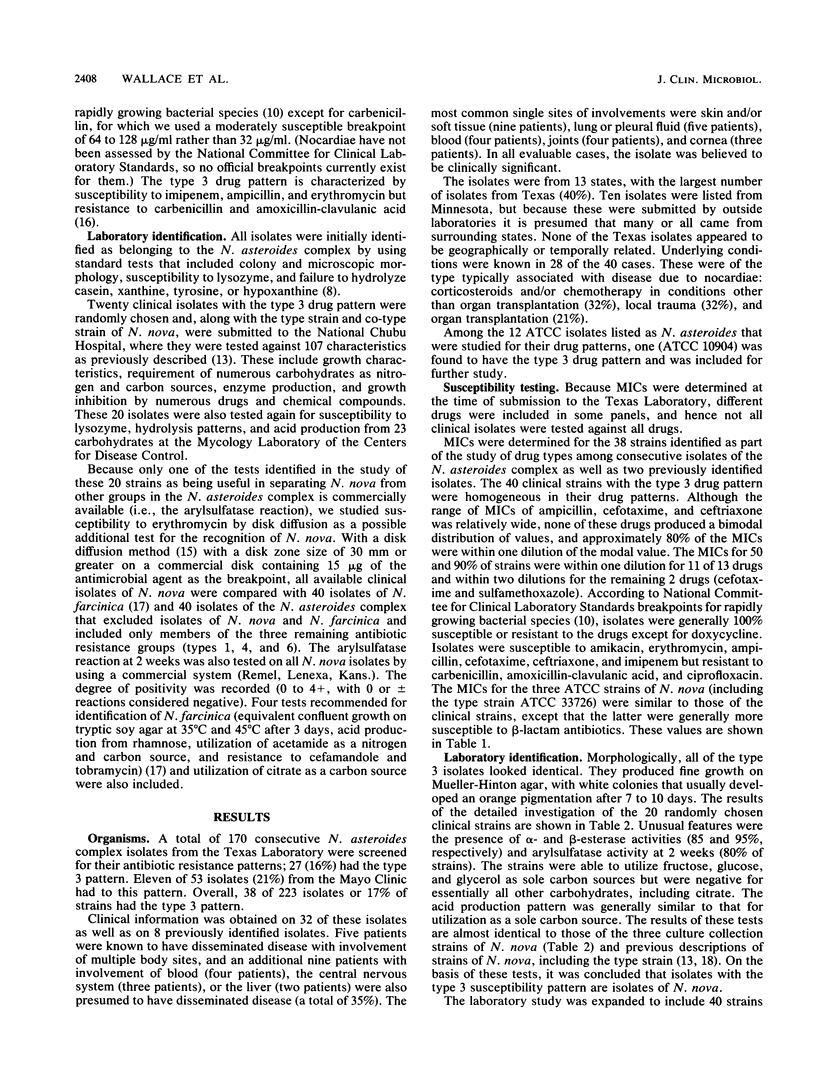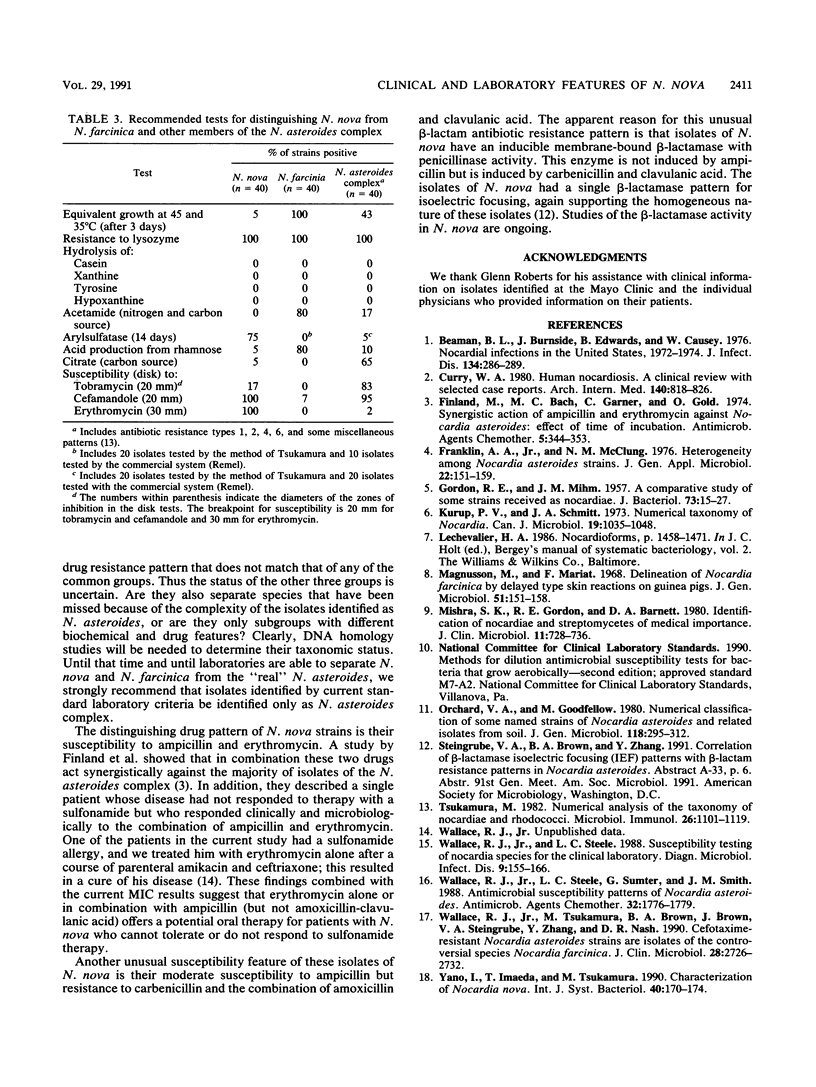Abstract
Recent studies have shown that Nocardia asteroides isolates have five major antibiotic resistance patterns; one of these patterns identifies isolates of Nocardia farcinica. In the current study, we investigated a second pattern characterized by susceptibility to ampicillin and erythromycin. This pattern was seen in 17% of 223 clinical isolates identified by standard techniques as N. asteroides and associated with diseases typical for nocardiae. Biochemically, isolates with this drug pattern were relatively homogeneous and identical to the type strain and previous descriptions of Nocardia nova. The strains studied were unique among nocardiae in having both alpha- and beta-esterase activity (85 and 95%, respectively). However, the arylsulfatase activity at 14 days (75%) and antimicrobial susceptibility patterns, including susceptibility to erythromycin (100%), were the only routinely available methods that would separate N. nova strains from other members of N. asteroides. N. asteroides should be considered a complex because current clinical identification schemes include isolates of N. farcinica and N. nova and may well include additional species. This is the first detailed description of N. nova as a pathogen in humans.
Full text
PDF




Selected References
These references are in PubMed. This may not be the complete list of references from this article.
- Beaman B. L., Burnside J., Edwards B., Causey W. Nocardial infections in the United States, 1972-1974. J Infect Dis. 1976 Sep;134(3):286–289. doi: 10.1093/infdis/134.3.286. [DOI] [PubMed] [Google Scholar]
- Curry W. A. Human nocardiosis. A clinical review with selected case reports. Arch Intern Med. 1980 Jun;140(6):818–826. doi: 10.1001/archinte.140.6.818. [DOI] [PubMed] [Google Scholar]
- Finland M., Bach M. C., Garner C., Gold O. Synergistic action of ampicillin and erythromycin against Nocardia asteroides: effect of time of incubation. Antimicrob Agents Chemother. 1974 Mar;5(3):344–353. doi: 10.1128/aac.5.3.344. [DOI] [PMC free article] [PubMed] [Google Scholar]
- GORDON R. E., MIHM J. M. A comparative study of some strains received as nocardiae. J Bacteriol. 1957 Jan;73(1):15–27. doi: 10.1128/jb.73.1.15-27.1957. [DOI] [PMC free article] [PubMed] [Google Scholar]
- Kurup P. V., Schmitt J. A. Numerical taxonomy of Nocardia. Can J Microbiol. 1973 Aug;19(8):1035–1048. doi: 10.1139/m73-164. [DOI] [PubMed] [Google Scholar]
- Magnusson M., Mariat F. Delineation of Nocardia farcinica by delayed type skin reactions on guinea pigs. J Gen Microbiol. 1968 Apr;51(1):151–158. doi: 10.1099/00221287-51-1-151. [DOI] [PubMed] [Google Scholar]
- Mishra S. K., Gordon R. E., Barnett D. A. Identification of nocardiae and streptomycetes of medical importance. J Clin Microbiol. 1980 Jun;11(6):728–736. doi: 10.1128/jcm.11.6.728-736.1980. [DOI] [PMC free article] [PubMed] [Google Scholar]
- Orchard V. A., Goodfellow M. Numerical classification of some named strains of Nocardia asteroides and related isolates from soil. J Gen Microbiol. 1980 Jun;118(2):295–312. doi: 10.1099/00221287-118-2-295. [DOI] [PubMed] [Google Scholar]
- Tsukamura M. Numerical analysis of the taxonomy of Nocardiae and Rhodococci. Microbiol Immunol. 1982;26(12):1101–1119. doi: 10.1111/j.1348-0421.1982.tb00260.x. [DOI] [PubMed] [Google Scholar]
- Wallace R. J., Jr, Steele L. C., Sumter G., Smith J. M. Antimicrobial susceptibility patterns of Nocardia asteroides. Antimicrob Agents Chemother. 1988 Dec;32(12):1776–1779. doi: 10.1128/aac.32.12.1776. [DOI] [PMC free article] [PubMed] [Google Scholar]
- Wallace R. J., Jr, Steele L. C. Susceptibility testing of Nocardia species for the clinical laboratory. Diagn Microbiol Infect Dis. 1988 Mar;9(3):155–166. doi: 10.1016/0732-8893(88)90025-9. [DOI] [PubMed] [Google Scholar]
- Wallace R. J., Jr, Tsukamura M., Brown B. A., Brown J., Steingrube V. A., Zhang Y. S., Nash D. R. Cefotaxime-resistant Nocardia asteroides strains are isolates of the controversial species Nocardia farcinica. J Clin Microbiol. 1990 Dec;28(12):2726–2732. doi: 10.1128/jcm.28.12.2726-2732.1990. [DOI] [PMC free article] [PubMed] [Google Scholar]


